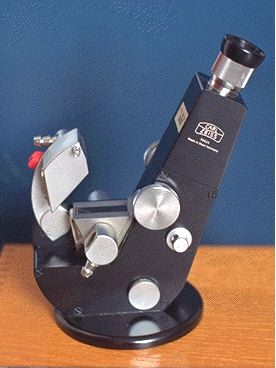

 The density of a salt solution depends on the concentration of the natrue of the salt and its concentration. Salt solutions lead to refraction of light in a concnetration dependent manner. Thus, one can determine the salt concentration and from that the density of salt solutions by measuring their refractive indices. This is conveniently done with an Abbé refractometer.
The density of a salt solution depends on the concentration of the natrue of the salt and its concentration. Salt solutions lead to refraction of light in a concnetration dependent manner. Thus, one can determine the salt concentration and from that the density of salt solutions by measuring their refractive indices. This is conveniently done with an Abbé refractometer.
From the refractive index, the density can be determnined with the following formula:
with ![]() = density at 25 °C and
= density at 25 °C and ![]() = refractive index .
= refractive index .
a and b are constants that depend on the salt used to establish gradient solutions. Some common salts and their coeffcients are shown below.
| salt | a | b | density range |
|---|---|---|---|
| CsBr | 9.9667 | 12.2876 | 1.25-1.35 g/ml |
| CsCl | 10.8601 | 13.4974 | 1.25-1.90 g/ml |
| Cs acetate | 10.7527 | 13.4247 | 1.80-2.05 g/ml |
| KBr | 6.4786 | 7.6431 | 1.10-1.35 g/ml |
| RbBr | 9.1750 | 11.2410 | 1.15-1.65 g/ml |

2. Place the drop on the cleaned prism top. Cover and observe through the eye piece. With the dial, move the border between dark and light so that it crosses the cross right in the centre, as shown here. Then take the reading on the upper scale; you should estimate the last digit. This will give the refractive index of KBr solution. In this example, the refractive index is 1.3353
3. Use the appropriate values and the formula given in the following table to calculate the respective densities.